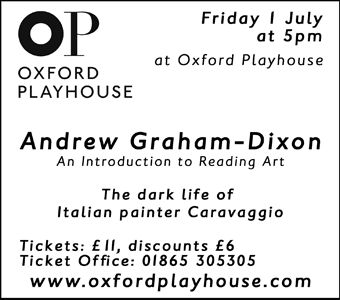July 4, 2011
These one-hour talks at the Playhouse by eminent television broadcasters are always fascinating. That nice besuited Andrew Graham-Dixon - the charming, genial, quietly authoritative art critic we know from The Culture Show and BBC documentaries - will he be the same in the flesh?
He makes a stark entrance, in blue jeans, un-tucked white shirt, hangdog face, looking tired and as if he really doesn't want to be there. He starts speaking so softly his microphone barely picks him up, and comes across as almost painfully shy. But as he starts to talk about his subject - the Baroque painter Caravaggio - he seems to forget he's on stage; his whole demeanour begins to change and his infectious enthusiasm takes over. About halfway through the talk he begins to realise that the audience is completely on his side, and by the end he's supremely confident, cracking jokes and cheerfully ranting about everything from early 17th Century Roman politics to whether Caravaggio slept with his serving boy - taking liberal swipes at Caravaggio's biographers and shamelessly plugging his own book in the process. It's about as far from a dry lecture on Baroque art as you could hope to get.
Graham-Dixon begins with an anecdote about recently interviewing Keith Richards (once an art college student): when Richards sees Leoni's sketch of Caravaggio he says, "He could be a Rolling Stone!" Indeed, as far as rolling stones go, Caravaggio could have put even Keef's blues heroes in the shade: pimping, killing, face-slashing, on the run with a price on his head from the Papacy - in any rock critic's eyes he'd be great copy.
But thankfully Graham-Dixon isn't fantastically interested in the 'bad boy of art' cliché. Instead he describes a supremely talented and devout intellectual who, when charged with commissions to paint some of the most over-painted scenes in art, would go back and re-read the Bible with such care, and eventually produce paintings of breathtaking originality. Graham-Dixon also explains why Caravaggio wasn't actually Baroque - hated the Baroque in fact, with its pomp and its authoritarian propaganda - and was driven instead to make popular, visceral art that spoke to those in poverty and suffering.
By the end of the talk, three things became apparent: i) he's done a lot of research for this book, ii) he's so emotional about his subject that he might well have got a fair bit wrong, and iii) this absolutely doesn't matter. This was not 'art critic as encyclopedia' but 'art critic as champion', and it revealed a passionate, partisan, even rather dark side to this popular TV critic. In the flesh, he didn't seem at all like the mild-mannered and rational analyser of cultural heritage. I imagine Caravaggio probably would have liked to have a drink with him. (Although, to be fair, by the end of the evening he would probably have tried to kill him.)
He makes a stark entrance, in blue jeans, un-tucked white shirt, hangdog face, looking tired and as if he really doesn't want to be there. He starts speaking so softly his microphone barely picks him up, and comes across as almost painfully shy. But as he starts to talk about his subject - the Baroque painter Caravaggio - he seems to forget he's on stage; his whole demeanour begins to change and his infectious enthusiasm takes over. About halfway through the talk he begins to realise that the audience is completely on his side, and by the end he's supremely confident, cracking jokes and cheerfully ranting about everything from early 17th Century Roman politics to whether Caravaggio slept with his serving boy - taking liberal swipes at Caravaggio's biographers and shamelessly plugging his own book in the process. It's about as far from a dry lecture on Baroque art as you could hope to get.
Graham-Dixon begins with an anecdote about recently interviewing Keith Richards (once an art college student): when Richards sees Leoni's sketch of Caravaggio he says, "He could be a Rolling Stone!" Indeed, as far as rolling stones go, Caravaggio could have put even Keef's blues heroes in the shade: pimping, killing, face-slashing, on the run with a price on his head from the Papacy - in any rock critic's eyes he'd be great copy.
But thankfully Graham-Dixon isn't fantastically interested in the 'bad boy of art' cliché. Instead he describes a supremely talented and devout intellectual who, when charged with commissions to paint some of the most over-painted scenes in art, would go back and re-read the Bible with such care, and eventually produce paintings of breathtaking originality. Graham-Dixon also explains why Caravaggio wasn't actually Baroque - hated the Baroque in fact, with its pomp and its authoritarian propaganda - and was driven instead to make popular, visceral art that spoke to those in poverty and suffering.
By the end of the talk, three things became apparent: i) he's done a lot of research for this book, ii) he's so emotional about his subject that he might well have got a fair bit wrong, and iii) this absolutely doesn't matter. This was not 'art critic as encyclopedia' but 'art critic as champion', and it revealed a passionate, partisan, even rather dark side to this popular TV critic. In the flesh, he didn't seem at all like the mild-mannered and rational analyser of cultural heritage. I imagine Caravaggio probably would have liked to have a drink with him. (Although, to be fair, by the end of the evening he would probably have tried to kill him.)




